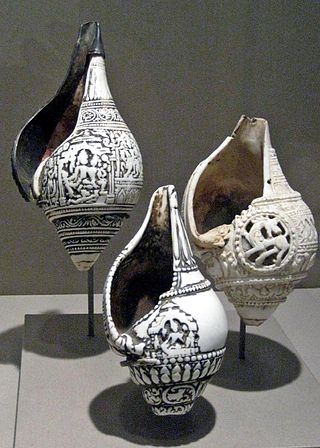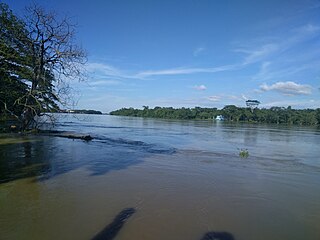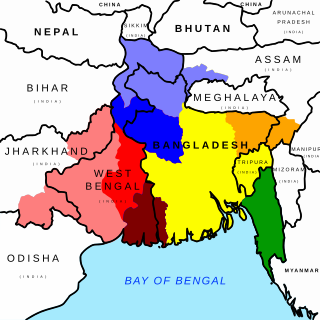
Conch is a common name of a number of different medium-to-large-sized sea snails. Conch shells typically have a high spire and a noticeable siphonal canal.

Dhakeshwari National Temple is a Hindu temple in Old Dhaka, Dhaka, Bangladesh. It is state-owned, giving it the distinction of being Bangladesh's 'National Temple'. The name "Dhakeshwari" means "Goddess of Dhaka". Bangladesh is the only country in the World to have a National Hindu Temple. It's one of the holiest Shakta pithas where the gem of Devi sati's crown fell but the gem is lost long ago and the main ancient Vigraha or stone murti is relocated to Kumortuli West Bengal during the partition time by the chief priest due to increased attacks on Hindu temples in Bangladesh.

The culture of Bangladesh is intertwined with the culture of the Bengal region of the Indian subcontinent. It has evolved over the centuries and encompasses the cultural diversity of several social groups of Bangladesh. The Bengal Renaissance of the 18th early 19th centuries, noted Bengali writers, saints, authors, scientists, researchers, thinkers, music composers, painters, film-makers have played a significant role in the development of Bengali culture. The culture of Bangladesh is deeply intertwined with the culture of the Bengal region. Basically, Bengali culture refers to the culture of Bangladesh. The Bengal Renaissance contained the seeds of a nascent political Indian nationalism which was the precursor in many ways to modern Indian artistic cultural expression.

Hinduism is the second largest religion in Bangladesh, as according to the 2022 Census of Bangladesh, approximately 13.1 million people responded that they were Hindus, constituting 7.95% out of the total population of 165.15 million people. In terms of population, Bangladesh is the third-largest Hindu populated country of the world, after the neighboring countries of India and Nepal. Hinduism is the second-largest religion in 61 out of 64 districts of Bangladesh, but there is no Hindu majority district in Bangladesh.

Dhaka District is a district in central Bangladesh, and is the densest district in the nation. It is a part of the Dhaka Division. Dhaka, the capital of Bangladesh, and rests on the eastern banks of the Buriganga River which flows from the Turag to the southern part of the district. The former Dhaka city corporation occupied only about a fifth of the area of Dhaka district until 2011 where the municipal corporation was fractionated and rearranged in North and South corporations due to being the economic, political and cultural centre of the district and also the country. Dhaka District consists of Dhaka, Keraniganj, Nawabganj, Dohar, Savar and Dhamrai upazila. Dhaka District is an administrative entity, and like many other cities, it does not cover the modern conurbation which is Greater Dhaka, which has spilled into neighbouring districts, nor does the conurbation cover the whole district, as there are rural areas within the district.

A shankha has religious ritual importance in Hinduism.

Dhaka (Dacca) is a modern megacity with origins dating to circa the 7th century CE. The history of Dhaka begins with the existence of urbanised settlements that were ruled by the Hindu Gauda Kingdom, Buddhist and Shaivite Pala Empire before passing to the control of the Hindu Sena dynasty in the 10th century CE. After the Sena dynasty, the city was ruled by the Hindu Deva Dynasty.

Balaganj is an upazila of Sylhet District in Sylhet Division, Bangladesh.

Kumortuli is a traditional potters' quarter in North Kolkata in West Bengal, India. The city is renowned for its sculpting prowess. It not only manufactures clay idols for various festivals but also regularly exports them.

Hinduism is the largest religious tradition in the Indian state of West Bengal with approximately 70.54% of the population identifying themselves as Hindus. The Hindus in West Bengal mostly belong to the Shakta, minority to Vaishnavite and a small community belong to Shaivite and other denominations. The vast majority of Hindus in West Bengal are Bengali Hindus numbering around 55 million and comprising 60.2% of the state population of 91.35 million (2011) but a notable section of non-Bengali Hindus also exist, particularly among Marwaris, Biharis, Odias, Gurkhas, Sindhis, Gujaratis and various tribal communities such as Koch, Santals, Munda, Mech people and particularly Adivadis numbering around 9.4 million comprising rest 10.3% of the state population.

Old Dhaka is a term used to refer to the historic old city of Dhaka, the capital of Bangladesh. It was founded in 1608 as Jahangirabad or Jahangirnagar, the capital of Mughal Province of Bengal and named after the Mughal emperor Jahangir. It is located on the banks of the Buriganga River. It was one of the largest and most prosperous cities of the Indian subcontinent and the center of the worldwide muslin trade. The then Nawab of Bengal Murshid Quli Khan shifted the capital from Dhaka to Murshidabad in the early-18th century. With the rise of Calcutta during the British rule, Dhaka began to decline and came to be known as the "City of Magnificent Ruins". The British however began to develop the modern city from the mid-19th century.

Bengali Hindus are an ethnoreligious population who make up the majority in the Indian states of West Bengal, Tripura, Andaman and Nicobar Islands, Jharkhand, and Assam's Barak Valley region. In Bangladesh, they form the largest minority. They are adherents of Hinduism and are native to the Bengal region in the eastern part of the Indian subcontinent. Comprising about one-third of the global Bengali population, they are the largest ethnic group among Hindus. Bengali Hindus speak Bengali, which belongs to the Indo-Aryan language family and adhere to Shaktism or Vaishnavism of their native religion Hinduism with some regional deities. There are significant numbers of Bengali-speaking Hindus in different Indian states. According to the census in 1881, 12.81 per cent of Bengali Hindus belonged to the three upper castes while the rest belonged to the Shudra and Dalit castes.

The Siddheshwari Kali Mandir is a Hindu temple located at 14 Siddheshwari Lane in Dhaka, Bangladesh, established in the year 1441 CE. It is known that the name of Siddheshwari has come from the temple's name. It is estimated that someone called Chand Rai established this temple.

The architecture of Dhaka is a confluence of many architectural styles. From the Sena temples built by Ballal Sen, to the Mughal architecture of the Mughals, to the Indo-Saracenic style of the colonial era, to 20th century steel and chrome of skyscrapers. Dhaka has a colonial core in the river port area, surrounded by progressively newer areas as one travels away from the Buriganga, punctuated with old temples, churches and mosques.
Shankharibazar massacre was a massacre of over 212 Bengali Hindus in the Shankharibazar area of Old Dhaka in East Pakistan on 26 March 1971 by the Pakistani occupation army. The survivors fled to the villages on the other side of the Buriganga, in the region now known as Keraniganj. Shankharibazar became deserted and dead bodies remained on the streets for quite a long time. The Pakistani establishment renamed the Shankharibazar Road to Tikka Khan Road.

Nawabpur Road is a road in Old Dhaka City, Bangladesh, and is associated with the Shankhari and Gulistan bazaars. It is a busy road often jammed with rickshaws, human drawn carts, and foot traffic.

Dhaka is the most populous city of Bangladesh and is characterized by its busy urban life and a variety of cultural experiences, including festivities, cuisine, entertainment, shopping, and sites of interest. The nature of these activities mirrors the secular character of the city's population. Important holidays include Language Movement Day, Independence Day, Victory Day, and Pahela Boishakh. Religious festivals include Eid ul-Fitr, Eid ul-Adha, Durga Puja, Buddha Purnima, etc. The culture of Dhaka is based on the culture of Bengal.

Sindur Khela, literally meaning 'vermillion game', is a Bengali Hindu tradition where women smear each other with sindur on Vijayadashami, the last day of the Durga Puja. On the day of the Vijayadashami after the conclusion of the ritual worship, married Bengali Hindu women apply sindur on the forehead and feet of the goddess and offer sweets to her. Then they put sindur on each other's faces and offer sweets to each other.
From 13 to 19 October 2021, Muslim mobs instigated communal violence against Hindu communities across Bangladesh during the Durga Puja festival, in response to a viral video where Quran was kept under a temple idol's feet. More than 50 temples and makeshift worship arrangements were vandalised all over Bangladesh.
Following the resignation of Sheikh Hasina on August 5, 2024, attacks began on the homes, businesses, and places of worship of the Hindu community in Bangladesh. The Hindu Buddhist Christian Unity Council reported that from August 4 to August 20, a total of 2,010 incidents of attacks on Hindus took place across the country within this 16-day period. Among the incidents, 157 families were violently ransacked, looted, and set ablaze, their businesses razed to the ground. 9 Hindus were killed in these attacks.























